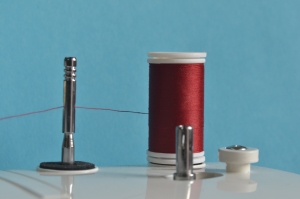 How can you win your trial?
How can you win your trial?
The other day I stopped by a meeting. I didn’t have a lot of time, so I didn’t plan to stay long, but I saw a map on a table. It had little dashed lines, weird-looking circles, and different shades of green. Another guy came over and we started talking about the map, but not really. We talked about the hills and valleys, ridges and streams, songs and floods and laughs and climbs; good stories, all.
That little map came alive. The map was what we saw and who we met, and the cadence we sang, still clear as a bell, at 10,000 feet.
We saw the blue sky and the bald eagles; felt the hot sun and the cold rain; wore the heavy backpacks and tasted the Lara Bars (don’t ask). The map wasn’t the story, but it let us live the story again.
It’s funny how little things can help tell a story; there’s no guaranty fancy gadgets or powerful software will. Lectures describing the minute details of an argument are no substitute for a good story. People love a good story.
A trial is really just a chance to tell your client’s story, to convince people she should get what she deserves. Even in commercial litigation, you get to put a name, and a face, on the company you represent, show the real people who make it work and tell their side of the story.
By the time you get to trial the facts are pretty much set in stone. There’s more than one way, however, to tell them. Present a straightforward timeline and you might put everyone to sleep. Tell a good story, with a who, a what, a where, a when, and, most importantly, a why, and people just might pay attention. Make it compelling and let the judge and the jury get to know your client, feel for your client, and chances are you’ll succeed; not always, but it can be your best shot.
If you read this blog you’ve probably seen this place the map shows. It’s gloriously miserable. It’s where you can sit at a stream and hear a subway car rumbling towards you just before you scramble up the overgrown side of a cliff to avoid the oncoming flood, barely picking up your gear as you go. The kind where you steer clear of the rattler minding its own business and try to avoid the streams that like to run through your tent. The kind with sleet so big you can have snowball fights with softballs in the summer, under double rainbows that come out when the sun comes back. The kind where you watch the sun rise over the canyons before you go to the top of the world, with snow-covered mountains and the desert on opposite sides. The kind you never quite dry off in, but no matter how wet you get, never quite get clean, either. Where you eat what you bring and hoist it at the end of the day because you want to be there to have it in the morning. And the place you laugh about, all this time later. Everyone should have a place like that. Continue reading
 I tried a case recently which made it clear that the way I did it might be a little out of the ordinary. Whether that’s a good or bad thing, is up to you.
I tried a case recently which made it clear that the way I did it might be a little out of the ordinary. Whether that’s a good or bad thing, is up to you. New York Business Lawyer Blog
New York Business Lawyer Blog


 How can you win your trial?
How can you win your trial? How can you prove something exists when it can’t be found? If you ask an investigator, or a New York Litigator, it may not be as hard as you think.
How can you prove something exists when it can’t be found? If you ask an investigator, or a New York Litigator, it may not be as hard as you think. We spent
We spent  It has been some time since we last spoke about the use of
It has been some time since we last spoke about the use of  Have you ever wanted to do absolutely nothing: nothing real, nothing hard, nothing serious, at least not for a little while? Maybe lie down on the beach, read a good book, go play a round of miniature golf with your family and friends? Just be a little silly, just a little?
Have you ever wanted to do absolutely nothing: nothing real, nothing hard, nothing serious, at least not for a little while? Maybe lie down on the beach, read a good book, go play a round of miniature golf with your family and friends? Just be a little silly, just a little? There’s a new term that’s making the rounds, which might make us reconsider whether common wisdom is always wise and might make trial lawyers re-think how they select jurors: pre-crastination. As we’ll see, it means that maybe trial attorneys shouldn’t decide whether someone can be a good juror in spite of his old age and frailty, but because of them.
There’s a new term that’s making the rounds, which might make us reconsider whether common wisdom is always wise and might make trial lawyers re-think how they select jurors: pre-crastination. As we’ll see, it means that maybe trial attorneys shouldn’t decide whether someone can be a good juror in spite of his old age and frailty, but because of them.  Trial lawyers are problem solvers. That is what they have to do and what their clients expect them to do. The biggest problem they face is how to persuade a jury. After all, the last time a trial went completely as planned was probably the first time one ever did.
Trial lawyers are problem solvers. That is what they have to do and what their clients expect them to do. The biggest problem they face is how to persuade a jury. After all, the last time a trial went completely as planned was probably the first time one ever did.  Lying and Insurance Fraud go together. Cheat, steal, get caught, admit it; which one doesn’t belong? Better yet, be honest when you cheat. No, that doesn’t work either. Most every time someone tries to get away with something he shouldn’t, chances are he’s going to lie about it somewhere along the line. Investigators need to know how to ask questions, elicit answers, and get at the truth; so, chances are, they should all know a good lie when they hear one.
Lying and Insurance Fraud go together. Cheat, steal, get caught, admit it; which one doesn’t belong? Better yet, be honest when you cheat. No, that doesn’t work either. Most every time someone tries to get away with something he shouldn’t, chances are he’s going to lie about it somewhere along the line. Investigators need to know how to ask questions, elicit answers, and get at the truth; so, chances are, they should all know a good lie when they hear one. We’ve spent a decent amount of time discussing how lawyers try to
We’ve spent a decent amount of time discussing how lawyers try to